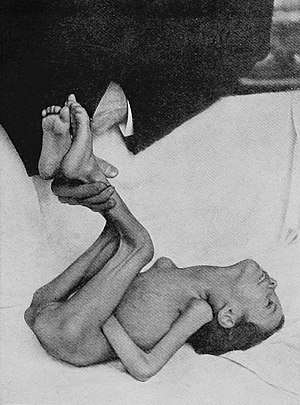Kernig's sign
Kernig's sign (after Waldemar Kernig (1840–1917), a Russian neurologist) is positive when the thigh is flexed at the hip and knee at 90 degree angles, and subsequent extension in the knee is painful (leading to resistance).[1] This may indicate subarachnoid hemorrhage or meningitis.[2] Patients may also show opisthotonus—spasm of the whole body that leads to legs and head being bent back and body bowed forward.
| Kernig's sign | |
|---|---|
 | |
| Positive Kernig's sign in cerebrospinal meningitis | |
| Differential diagnosis | subarachnoid hemorrhage or meningitis |
References
- Kernig VM (1882). "Ein Krankheitssymptom der acuten Meningitis". St Petersb Med Wochensch. 7: 398.
- O'Connor, Simon; Talley, Nicholas Joseph (2001). Clinical Examination: A Systematic Guide to Physical Diagnosis. Cambridge, MA: Blackwell Publishers. p. 363. ISBN 0-632-05971-0.
This article is issued from Wikipedia. The text is licensed under Creative Commons - Attribution - Sharealike. Additional terms may apply for the media files.